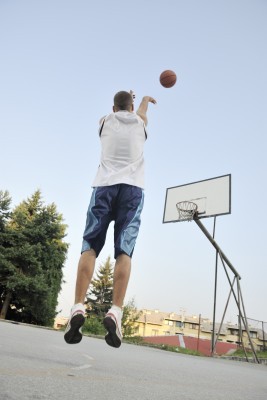
12 Tips for Basketball Training To Improve Your Athlete’s Game
Posted in:
With the air getting cooler and the days getting shorter, we know that basketball season is right around the corner. Now is a good time to start preparing for the season and thinking about your basketball training. Creating an effective program with the right basketball drills and strength training is the key to making the most out of your time before the season.
To help you get started on your basketball training, we wanted to share an excerpt from Alan Stein’s 12 Thoughts For The Basketball Pre-Season. You can find more posts from Alan on his blog. Alan Stein is the owner of Stronger Team and the Head Strength & Conditioning coach for a nationally renowned High School basketball program. Through his extensive work with elite high school, college, and NBA players, Alan brings a wealth of knowledge to basketball training.
 A basketball player’s athleticism is the foundation of their entire game. If a player can improve their strength, power, explosiveness, agility, reaction, quickness, flexibility and conditioning level, then they can perform the skills of shooting, passing, ball handling, rebounding, and defending at a much higher level. They can also perform their skills with more efficiency and perform them for longer before fatigue sets in. That is why the best players are in the best shape!
A basketball player’s athleticism is the foundation of their entire game. If a player can improve their strength, power, explosiveness, agility, reaction, quickness, flexibility and conditioning level, then they can perform the skills of shooting, passing, ball handling, rebounding, and defending at a much higher level. They can also perform their skills with more efficiency and perform them for longer before fatigue sets in. That is why the best players are in the best shape!
Just as a player’s athleticism is the foundation of their game, the pre-season lays the foundation for the upcoming season. What players do from the start of the school year until the day of the first practice will determine the type of season they have.
With proper and purposeful training, players can make impressive strides in their hand/eye coordination, footwork, acceleration/deceleration, reaction, strength, mobility, and stamina.
It is these ‘little things’ that make a BIG difference!
12 Tips For Your Pre-Season Basketball Training:
- Goals:
– No injuries during training and workouts.
– Train to reduce preventable injuries.
– Train to improve performance on the court. - Basketball is not a speed game! It is an agility game, a change of direction game and an acceleration/deceleration game. Your training should reflect this.
- There is a difference between ‘working out’ and ‘training.’ Training has a purpose and takes you closer to your goal!
- Just because a workout was hard, doesn’t mean it was productive. It must be purposeful! Shooting 20 full-court lay-ups with a weighted vest and a medicine ball is very hard… but won’t get you any better. Train hard, train smart!
- It takes 10,000 hours to truly master a skill. Repetition is not a form of punishment. It can take 5,000-10,000 reps to change a movement pattern.
- Why should you strength train? Do you want to be the bug or the windshield? Seven days without strength training makes one weak.
- Proper strength training for basketball is more than just bench pressing and squatting. You must train your feet & ankles, core, and grip in addition to your upper and lower body.
- Tight, weak ankles and feet limit your ability to run and jump as fast and as high as possible as well as increase the occurrence of injury. Train your feet! It all starts with your feet!
- Most basketball bodies were not made to back squat safely, particularly under load. Utilize lunges, step-ups, and single-leg deadlifts as alternatives.
- Having a huge bench press has zero correlation to basketball success. Ask Kevin Durant. Enough said.
- If you stand on one leg, it is physically impossible to move your knee without moving your ankle or hip. Everything is connected and everything functions together. That is why having strong & mobile ankles and hips are the key to knee health!
- Basketball conditioning stats to keep in mind when designing your training program (from the 2010 BSMPG Clinic):
– Average heart rate: 165-170 bpm
– High-intensity sprints occur every 20-30 seconds
– 100+ high-intensity sprints per game
– 40-50 maximal jumps per game
– Change in movement every 2-3 seconds
– 30% of time is spent defensive sliding
– 15% of time is in high intensity
– Movement patterns: Jogging — running — jumping/landing — backpedaling — planting/cutting — pivoting — defensive sliding
– Categories — Offensive, Defensive, and Transition movements
– Breakdown of categories — Guard specific, Wing specific, Post specific
To read more tips for your pre-season basketball training, visit the Stronger Team blog. Are you a basketball coach or basketball club sports organization admin? Do you or someone you know need help managing their sports team or club? Sign up for a free 21-day trial today. Or check out our club and league solution, TeamSnap for Clubs and Leagues if your team is part of a larger sports organization.
